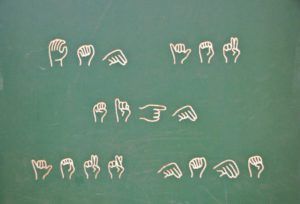
Oh the milestones. They make all the sweat, tears, and other assorted bodily fluids worthwhile. Like the first time my Little One rolled over. And when she started to crawl. Then there was her first diaper blow-out, so cute! And who can forget her first numero dos in the bath. Aaaand then her second when I was in the tub with her.
So. Much. Joy.
For various reasons, I probably shed a tear or two when these magic moments finally transpired. But I was in no way prepared for the deluge of emotion that hit me when my baby first showed signs of language development. Around six months, LO babbled a “word” that sounded a lot like mama. At the moment, she was in distress and so I was more than delighted to take this as an indication that she could identify me and call for me when needed. (Yes, I am aware that it was likely a big fat coincidence.) It didn’t matter though. One word and we were off to the verbal races. After hearing that mama, I became more aware of my speech: the words themselves, their meaning, and their frequency. I began to describe situations, objects, and abstractions to my baby. I talked to her constantly no matter who was (or wasn’t) around. Then we waited for the language to arrive. And waited. Though the babbling continued, discernible words didn’t exactly fill up the brag book.
And then one day, I saw a sign.
It was my sister, making the hand sign for “milk” and telling me about this crazy thing called baby sign language. I made the sign for rolling my eyes. She volunteered books, optimistic anecdotes, and encouragement anyway. I volunteered some unenthusiastic gratitude thinking, why bother? My baby is babbling and will be talking in no time. Teaching her sign language would be a waste of time.
I could not have been more wrong.
I took to the streets and surveyed some ladies in my mama groups: what do you think of this baby sign stuff? More than a handful had tried it and some even experienced success. So around seven months, we apathetically worked in some basic words. Given we spent most of our days carbo-loading, we started with the obvious: milk, eat, more, and all done. I did and still do say the word each time I make the sign. Months went by and LO showed little interest in reciprocating this strange hand jive her mama was into. And then one day, around ten months, she just signed back, “all done.” Floored and a bit verklempt, I scrambled for the book. Could it be she was simply holding out on me? Within days she signed back: milk, eat, and more. I gobbled up this delicious new diet of “words.” We began to incorporate the signs for objects we encountered on a daily basis. Book and baby were easy and obvious additions. Other signs, like favorite foods cheese and egg, were more complex. Still, she tried. Immediately I noticed that the more useful she found the word – like bath and berry, two of her favorite things – the more quickly she mastered the sign. I followed her lead and mastered a few useful words of my own. Just some basics like poop, and wait!
At 15 months, we’re signing more words every day.** She doesn’t master them right off, but repetition is key throughout. The big lesson for me is that what seemed like months of nothing, turned into to a lot of something. What I thought was lack of interest was simply her working at her own pace.
Interested in baby signing? We’ve compiled a list of resources below. I recommend starting around 6/7 months. Keep repeating the signs and don’t give up! Begin with the basics and once baby begins to sign back, add a new sign every few days. Often, I’ll look up a few new signs on my smartphone before bed. Use playtime as an opportunity to increase baby’s vocabulary with words from the toy box. Take notes, practice! practice!, and above all, have fun.
Baby signs are based on American Sign Language (ASL). On April 15, we celebrate National ASL Day which commemorates the opening of the first school for the deaf 200 years ago this year.
Resources
Books
Baby Talk, Monica Beyer
In Baby Talk, the author neatly summarizes the who, what, and why. Of note: to sign with your baby, you certainly don’t need a baby-specific resource. However, the key benefit to using such a guide is that the signs are generally presented in the order in which you’ll begin to use them.
Talk to the Deaf, Lottie Riekehof
With over 1000 basic signs, I find most of what I’m looking for in this book. It’s basically a small dictionary yet I can easily toss it in my bag. Another benefit is the written instruction that accompanies each illustration. I find the signs easy to mimic, which is not the case with every resource I’ve consulted.
Web
Baby Sign Language dot com
Baby Sign Language dot com offers a wealth of easily accessible, printable FREE information with the added option to purchase. Books, posters, flashcards, and tutorials focus on words that will be immediately useful for particular stages.
Baby Sign Language dictionary
With over 600 commonly used parent/child signs, this sub-page is a frequently visited reference on our browser. I’ve bookmarked this link on my phone for quick access. Signs are presented in clear and concise videos without a lot of unnecessary talk.
Apps
Baby Sign Language Dictionary
The free app includes helpful and quick videos for 40 signs, while the paid ($2.99) includes more than 340. Both versions offer short quizzes to test your retention.
My Smart Hands
My Smart Hands lite includes 120 signs while the paid ($.99) has over 300 signs. The developer also has 8 other free and paid sign language apps that build on ASL skills at all ages.
Classes
Madison Area Technical College
Each semester, MATC offers non-credit ASL courses beginning with level I and continuing to level III.*
*Information current as of April 10, 2017.
**airplane, all done, apple, baby, bath, berry, bird, book, cheese, dada, dog, egg, family, friend, grandma, grandpa, love, poop, rice, sleep, vegetable, walk,











